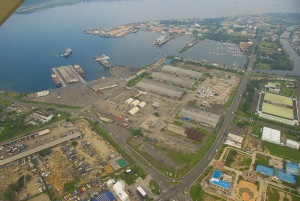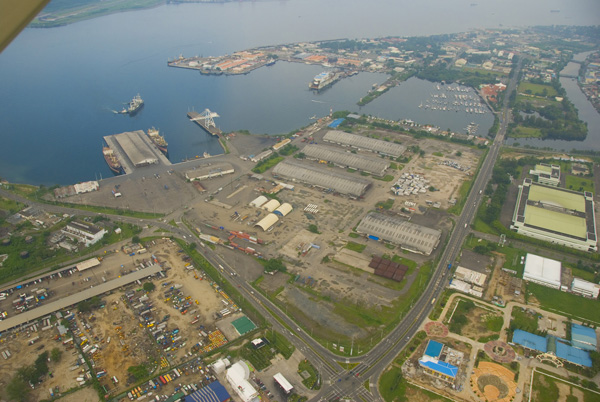The Port of Subic Bay, with its strategic location in northern Philippines, continues to modernize its facilities and expand its infrastructure to establish itself as a regional gateway to the growing ASEAN market and fill the capacity shortage in the region.
 The ongoing modernization efforts are part of the national government’s Subic Bay Port Development Project, which mandates improving the port system and road network within and around the port community to create a world-class logistics and investment hub for Southeast Asia.
The ongoing modernization efforts are part of the national government’s Subic Bay Port Development Project, which mandates improving the port system and road network within and around the port community to create a world-class logistics and investment hub for Southeast Asia.
Under the plan, the port, located within the Subic Bay Freeport and Special Economic Zone, has opened two modern berths—the New Container Terminals 1 and 2 (NCT-1 and NCT-2)—to help decongest the Port of Manila.
The newly constructed terminals—NCT 2 is expected to be operational by August this year—will have a combined capacity of 600,000 TEUs to help ease the projected capacity dearth of 14 million 20-foot equivalent units (TEUs) in Southeast Asia.
A third terminal for general cargo is also being considered.
Road networks
At the same time, a 3.6-kilometer access road with a reclamation volume of 335,000 cubic meters has been completed to connect the two new terminals to the Argonaut Highway, one of the main thoroughfares at the port, all the way to Tipo Expressway, Subic’s nearest entry-exit point to and from Manila.
An arterial highway called the Subic-Clark-Tarlac Expressway has also been opened, creating the Subic-Clark corridor that efficiently moves people, goods, and services from Subic Bay all the way to Tarlac province in just 45 minutes.
The four-lane, 94-kilometer toll road running from Subic Bay to the Clark Special Economic Zone up to Tarlac now links the three growth centers in the area: Subic Bay Freeport and Special Economic Zone, Clark Freeport Zone and Tarlac Industrial Park.
The road is supported by a network of transport infrastructure, including four major bridges, eight interchanges, 29 minor bridges, 44 underpasses, toll plazas, traffic control systems, and assistance centers.
To further expand the Subic-Clark corridor, the Subic Bay Metropolitan Authority (SBMA), the government agency that operates and supervises the Subic port, plans to extend the borders of the Subic economic zone to nearby Zambales and Bataan provinces to accommodate additional manufacturing, heavy industries and other potential investments.
More projects in the pipeline
The SBMA still has other projects lined up, such as establishing additional calls at Subic to create trade links to Singapore, Japan, and China, and doubling cargo volume by collecting cargoes from nearby provinces. The long-term goal, it said, is to support the Port of Manila in serving the maritime and logistics needs of the ASEAN region.
The Port of Subic Bay has been an ISO 9001-2000-certified port since 2003. Its NCT-1 and NCT-2 has a land area of 28.6 hectares up to 30 hectares including the access road, a natural deep harbor with 13.7 meters controlling depth, and a berth measuring 560 meters in length. If the possibility of dredging is considered, the harbor of the container terminals can be deepened to up to 15 meters. The Port has 15 operational piers and wharves capable of handling all kinds of sea vessels, including large cargo ships as Panamax class vessels, as well as oil tankers and aircraft carriers. Its fairways have navigational light buoys for safe navigation by incoming and outgoing vessels. It also has an accredited pilotage association manned by highly trained and experienced harbor pilots.
Port facilities are capable of handling various kinds of goods, such as bulk fertilizer, bulk grains, and general cargo coming from the southern islands of the Philippines, as well as to transship cargo to and from the trans-Pacific, Japan, Korea, Singapore, Europe, Middle East, and other Asian ports.
“Amid growing competition from other ports in Asia working to attract more business through capacity expansion and facilities upgrades, Subic Bay keeps up by promoting efficient, effective and transparent business processes,” the SBMA said.
“We work to prioritize physical and manpower infrastructure to make the Port of Subic Bay truly world-class and easy to do business with, and to balance development and environmental protection within the Freeport Zone for a safe and secure port.”
Boosting cargo traffic
Subic port’s actual containerized cargo volumes have grown by 10.87 percent to 27,671 TEUs in 2011 since it started in 2007 with 24,958 TEUs. Volumes for containerized cargo are forecast to increase by 15.23 percent by 2016.
There is still much room for volume growth: The port remains significantly underutilized; the NCT-1 capacity usage is only about 8 percent for containerized cargo.
Actual non-containerized cargo volumes have seen a 36.49 percent increase, from 1.9 million metric tons in 2007 to 2.6 million metric tons in 2011, and are predicted to increase by 320.89 percent by 2016.
Subic Port authorities are also considering a specialized rate for domestic non-containerized cargoes to increase local shipments at the port.
Wooing local and global investments
To attract more local and global investors, port authorities are creating an ideal business climate for multimodal logistics and distribution companies and targeting the emerging market of BRICS (Brazil, Russia, India, China, and South Africa).
The Subic Bay free port offers zero duties on imports and freedom from foreign exchange control. Its seaport tariff rates and vessel and cargo charges are lower than those of other ports in the Philippines and around the world.
Foreign investments at the port are led by the Korean shipbuilding giant Hanjin Heavy Industry and Construction Co. Others include Greenbeach Powertech, HHIC-Tech, Subic Drydock, Australasia Marine Alliance, Safehull Marine Technologies, and Idess Maritime Centre (Subic), Juken Sangyo (Phils.), Hitachi Air-conditioners Phils. and Hitachi Terminals Phils.
The SBMA, together with its port operator, the Subic Bay International Terminal Corp, has been organizing conferences to spread information about the free port’s advantages. On August 23-24, 2012, it will hold the Subic Bay Maritime Conference & Exhibit 2012 to create awareness of Subic Bay as Asia’s emerging logistics and investments hub. The conference will be held at the Subic Bay Exhibition and Convention Center in Subic Bay Gateway Park.





